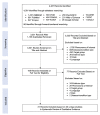Integrating patient values and preferences in healthcare: a systematic review of qualitative evidence
- PMID: 36400731
- PMCID: PMC9677014
- DOI: 10.1136/bmjopen-2022-067268
Integrating patient values and preferences in healthcare: a systematic review of qualitative evidence
Abstract
Objectives: To identify and thematically analyse how healthcare professionals (HCPs) integrate patient values and preferences ('values integration') in primary care for adults with non-communicable diseases (NCDs).
Design: Systematic review and meta-aggregation methods were used for extraction, synthesis and analysis of qualitative evidence.
Data sources: Relevant records were sourced using keywords to search 12 databases (ASSIA, CINAHL, DARE, EMBASE, ERIC, Google Scholar, GreyLit, Ovid-MEDLINE, PsycINFO, PubMed-MEDLINE, Scopus and Web of Science).
Eligibility criteria: Records needed to be published between 2000 and 2020 and report qualitative methods and findings in English involving HCP participants regarding primary care for adult patients.
Data extraction and synthesis: Relevant data including participant quotations, authors' observations, interpretations and conclusions were extracted, synthesised and analysed in a phased approach using a modified version of the Joanna Briggs Institute (JBI) Data Extraction Tool, as well as EPPI Reviewer and NVivo software. The JBI Critical Appraisal Checklist for Qualitative Research was used to assess methodological quality of included records.
Results: Thirty-one records involving >1032 HCP participants and 1823 HCP-patient encounters were reviewed. Findings included 143 approaches to values integration in clinical care, thematically analysed and synthesised into four themes: (1) approaches of concern; (2) approaches of competence; (3) approaches of communication and (4) approaches of congruence. Confidence in the quality of included records was deemed high.
Conclusions: HCPs incorporate patient values and preferences in healthcare through a variety of approaches including showing concern for the patient as a person, demonstrating competence at managing diseases, communicating with patients as partners and tailoring, adjusting and balancing overall care. Themes in this review provide a novel framework for understanding and addressing values integration in clinical care and provide useful insights for policymakers, educators and practitioners.
Prospero registration number: CRD42020166002.
Keywords: adult cardiology; adult oncology; asthma; general diabetes; general medicine (see internal medicine); primary care.
© Author(s) (or their employer(s)) 2022. Re-use permitted under CC BY-NC. No commercial re-use. See rights and permissions. Published by BMJ.
Conflict of interest statement
Competing interests: CH receives grant funding from the NIHR School of Primary Care Research. He has received financial remuneration from an asbestos case and given legal advice on mesh and hormone pregnancy tests cases. He has received expenses and fees for his media work, for teaching EBM and is also paid for his GP work in NHS out of hours. He has also received income from the publication of a series of toolkit books and for appraising treatment recommendations in non-NHS settings. He is Director of CEBM and former editor-in-chief of BMJ-EBM. No competing interests for other authors.
Figures
References
Publication types
MeSH terms
LinkOut - more resources
Full Text Sources
Medical
Miscellaneous



